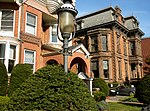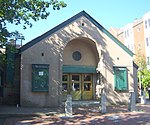St. Stanislaus Parish (New Haven, Connecticut)
1901 establishments in Connecticut20th-century Roman Catholic church buildings in the United StatesChurches in New Haven, ConnecticutPolish-American Roman Catholic parishes in ConnecticutRoman Catholic churches completed in 1904 ... and 2 more
Roman Catholic churches in ConnecticutRoman Catholic parishes of Archdiocese of Hartford

St. Stanislaus Parish (Polish: Parafia św. Stanisława Biskupa i Męczennika w New Haven), designated for Polish immigrants in New Haven, Connecticut, United States, was founded on December 28, 1901. It is one of the Polish-American Roman Catholic parishes in New England in the Archdiocese of Hartford.
Excerpt from the Wikipedia article St. Stanislaus Parish (New Haven, Connecticut) (License: CC BY-SA 3.0, Authors, Images).St. Stanislaus Parish (New Haven, Connecticut)
Second Company Governor's Foot Guard Memorial Highway, New Haven
Geographical coordinates (GPS) Address Nearby Places Show on map
Geographical coordinates (GPS)
| Latitude | Longitude |
|---|---|
| N 41.312222222222 ° | E -72.915222222222 ° |
Address
Upper State Street Historic District
Second Company Governor's Foot Guard Memorial Highway
06510 New Haven
Connecticut, United States
Open on Google Maps








